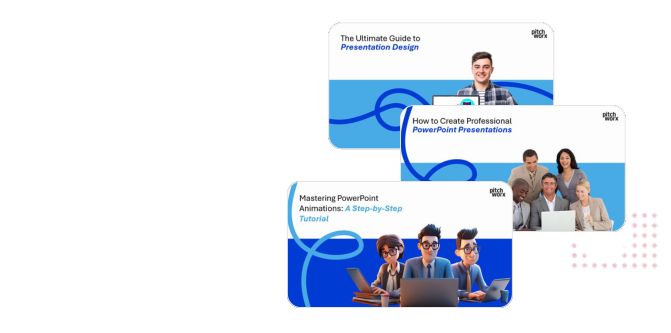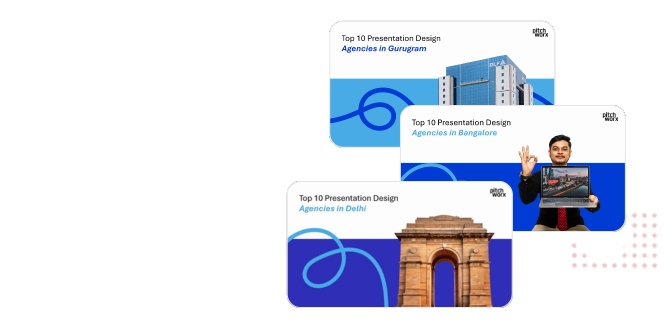Published: August 12, 2025 | Reading Time: 13 minutes | Author: PitchWorx Design Team
Table of Contents
- Introduction
- Understanding Data Visualization Fundamentals
- 1: Bar Charts – Comparing Categories & Rankings
- 2: Line Charts – Tracking Trends Over Time
- 3: Pie Charts – Showing Parts of A Whole
- 4: Scatter Plots – Revealing Relationships Between Variables
- 5: Area Charts – Emphasizing Magnitude of Change
- 6: Histograms – Understanding Data Distribution
- 7: Heat Maps – Visualizing Complex Data Matrices
- 8: Waterfall Charts – Tracking Cumulative Changes
- 9: Funnel Charts – Visualizing Process Flow & Conversion
- 10: Gantt Charts – Project Timeline & Resource Management
- Choosing The Right Chart Type: Decision Framework
- Professional Implementation with Expert Services
- Measuring Visualization Effectiveness
- Frequently Asked Questions
- Conclusion
Listen for The Guide
Introduction
In today’s data-driven business environment, the ability to present complex information through clear, compelling visualizations has become essential for success. Whether you’re presenting quarterly results to stakeholders, pitching to investors, or communicating research findings to your team, choosing the right chart type can make the difference between confusion and clarity, between rejection and approval.
Research from the Harvard Business Review shows that presentations containing effective data visualizations are 43% more persuasive than those relying solely on text. Furthermore, audiences retain 65% of visual information three days later, compared to only 10% of text-based information. This dramatic difference highlights why professional Presentation Design Agency services increasingly focus on data visualization expertise as a core competency.
The challenge lies not just in creating charts, but in selecting the most appropriate visualization method for your specific data set and communication objectives. Each chart type serves distinct purposes, and understanding these differences enables you to transform raw numbers into compelling stories that drive business decisions and inspire action.
This comprehensive guide explores ten essential chart types that every business professional should master, providing practical examples, implementation strategies, and expert insights to help you present data with maximum impact and clarity.
Understanding Data Visualization Fundamentals:-
Before diving into specific chart types, it’s crucial to understand the fundamental principles that guide effective data visualization. The primary goal is always to communicate information clearly and accurately while making complex data accessible to your intended audience.
Core principles of effective data visualization:
- Clarity: Information should be immediately understandable
- Accuracy: Data representation must be truthful and precise
- Efficiency: Charts should convey maximum information with minimum cognitive load
- Relevance: Visualizations should directly support your communication objectives
- Aesthetic appeal: Professional design enhances credibility and engagement
Professional PowerPoint Design Services incorporate these principles systematically, ensuring that every chart not only looks professional but also communicates effectively with the intended audience.
1: Bar Charts – Comparing Categories & Rankings:-
Bar charts excel at comparing different categories or showing rankings within data sets. They provide immediate visual comparison capabilities that make differences and patterns obvious to audiences.
When To Use Bar Charts:
Bar charts work best for:
- Comparing sales performance across different regions or time periods
- Showing ranking information like top-performing products or services
- Displaying survey results with categorical responses
- Presenting budget allocations across departments or projects
- Illustrating market share comparisons between competitors
Best Practices for Bar Chart Design:
Horizontal vs. Vertical Orientation:
- Use horizontal bars when category names are long or numerous
- Vertical bars work best for time-based comparisons or when space is limited
- Maintain consistent spacing between bars for professional appearance
- Order categories logically (alphabetical, by value, or chronological)
Example: UAE Market Performance Analysis
A Dubai-based retail company worked with Pitchworx to redesign their quarterly performance presentations. Their original spreadsheet data showed regional sales figures, but the information was difficult to interpret quickly during board meetings.
The transformation involved creating clean, professional bar charts that immediately highlighted:
- Dubai region leading with AED 12.3 million in quarterly sales
- Abu Dhabi following with AED 8.7 million
- Northern Emirates showing 23% growth despite lower absolute numbers
- Clear visual ranking that enabled instant performance assessment
This simple visualization change reduced meeting discussion time by 40% while improving strategic decision-making quality.
2: Line Charts – Tracking Trends Over Time:-
Line charts are the gold standard for displaying how data changes over time, making them indispensable for trend analysis, forecasting, and performance tracking.
Optimal Applications for Line Charts:
Line charts excel when presenting:
- Financial performance tracking over months, quarters, or years
- Website traffic patterns and digital marketing metrics
- Customer acquisition and retention trends
- Production output or quality metrics over time
- Market price fluctuations and economic indicators
Design Excellence in Line Charts:
Key design considerations:
- Use consistent time intervals on the horizontal axis
- Limit lines to 3-4 maximum for clarity
- Choose distinct colors and line styles for multiple series
- Include clear legends and data point labels when necessary
- Highlight significant events or changes with annotations
Chart: Presentation Design Service Demand Growth (2020-2024)
| Year | Basic Design Requests | Professional Agency Demand | Advanced Data Viz | Interactive Presentations |
|---|---|---|---|---|
| 2020 | 1,200 | 340 | 85 | 12 |
| 2021 | 1,450 | 520 | 145 | 34 |
| 2022 | 1,680 | 780 | 220 | 67 |
| 2023 | 1,820 | 1,150 | 340 | 123 |
| 2024 | 1,950 | 1,480 | 465 | 198 |
Based on market research across UAE PowerPoint Design Agency sector
This data clearly shows the increasing sophistication in presentation design demands, with professional agency services and advanced visualization techniques showing the strongest growth rates.
3: Pie Charts – Showing Parts of A Whole:-
Pie charts effectively display how individual components contribute to a total, making them ideal for showing proportions, percentages, and composition breakdowns.
Strategic Use of Pie Charts:
Pie charts work best for:
- Budget breakdowns and expense allocations
- Market share analysis and competitive positioning
- Survey response distributions with limited categories
- Resource allocation across projects or departments
- Demographic composition of customer bases
Pie Chart Design Guidelines:
Maximizing effectiveness:
- Limit segments to 5-7 maximum for clarity
- Start largest segment at 12 o’clock position
- Use contrasting colors with consistent saturation levels
- Include percentage labels for precise communication
- Consider exploding key segments for emphasis
Critical Limitations:
Pie charts become ineffective when:
- Comparing similar-sized segments
- Displaying more than 7 categories
- Showing changes over time (use line charts instead)
- Precise comparison is more important than proportion
4: Scatter Plots – Revealing Relationships Between Variables:-
Scatter plots excel at revealing correlations, patterns, and relationships between two or more variables, making them invaluable for analysis and hypothesis testing.
Scatter Plot Applications:
Use scatter plots to explore:
- Correlation between marketing spend and revenue generation
- Relationship between employee experience and productivity metrics
- Price vs. demand analysis for product positioning
- Performance metrics correlation in operational analysis
- Risk vs. return analysis in investment presentations
Advanced Scatter Plot Techniques:
Enhancement strategies:
- Use bubble sizes to represent third variables
- Color-code points by categories for additional insights
- Add trend lines to highlight correlations
- Include confidence intervals for statistical presentations
- Annotate outliers and significant data points
Example: Customer Satisfaction vs Revenue Correlation
A UAE hospitality company discovered through scatter plot analysis that customer satisfaction scores above 8.5 correlated strongly with 34% higher revenue per customer. This insight, presented through professional PowerPoint Presentation Design Services, convinced leadership to invest AED 2.3 million in service quality improvements.
5: Area Charts – Emphasizing Magnitude of Change:-
Area charts combine the trend-showing capabilities of line charts with visual emphasis on the magnitude of values, making them powerful for showing cumulative effects and proportional changes.
Area Chart Strengths:
Area charts effectively display:
- Cumulative revenue or profit growth over time
- Stacked contributions from different sources or categories
- Volume changes that need visual weight emphasis
- Portfolio composition changes over time periods
- Resource consumption patterns and capacity utilization
Stacked vs Unstacked Area Charts:
Stacked area charts show both individual contributions and total values simultaneously, ideal for presenting how different revenue streams contribute to overall business growth.
Unstacked area charts compare multiple series while emphasizing magnitude, perfect for comparing performance between different business units or time periods.
6: Histograms – Understanding Data Distribution:-
Histograms reveal the distribution patterns within your data sets, showing frequency, central tendencies, and variability that other chart types cannot effectively communicate.
Histogram Applications:
Histograms excel for:
- Analyzing customer age distributions for marketing targeting
- Quality control showing product measurement variations
- Performance evaluation displaying score or rating distributions
- Financial analysis revealing income or spending patterns
- Operational metrics showing response time or processing distributions
Design Considerations for Histograms:
Technical requirements:
- Choose appropriate bin widths for meaningful patterns
- Ensure continuous data on horizontal axis
- Use consistent bin sizes for accurate interpretation
- Include clear labeling of frequency or percentage scales
- Consider overlaying normal distribution curves for comparison
7: Heat Maps – Visualizing Complex Data Matrices:-
Heat maps use color intensity to represent data values across two dimensions, making them excellent for revealing patterns in large, complex data sets.
Heat Map Use Cases:
Heat maps effectively display:
- Website user behavior patterns and click tracking
- Sales performance across regions and time periods
- Correlation matrices showing variable relationships
- Capacity utilization across departments and shifts
- Risk assessment matrices for project or operational analysis
Color Strategy for Heat Maps:
Effective color schemes:
- Use sequential colors (light to dark) for continuous data
- Implement diverging colors for data with natural midpoints
- Ensure colorblind-friendly palettes for accessibility
- Maintain consistent scale ranges for accurate interpretation
- Include clear legends explaining color-value relationships
8: Waterfall Charts – Tracking Cumulative Changes:-
Waterfall charts excel at showing how an initial value changes through a series of positive and negative adjustments, making them ideal for financial analysis and process visualization.
Waterfall Chart Applications:
Use waterfall charts for:
- Revenue bridge analysis showing factors affecting quarterly changes
- Cost breakdown analysis identifying savings and increases
- Project timeline showing milestone achievements and delays
- Customer acquisition funnels displaying conversion losses
- Cash flow analysis tracking sources and uses of funds
Example: Quarterly Revenue Analysis
A UAE technology company used waterfall charts in their investor presentations to clearly communicate revenue growth factors. Starting with Q3 revenue of AED 8.2 million, the chart showed:
- New customer acquisition: +AED 1.4 million
- Existing customer expansion: +AED 0.8 million
- Customer churn: -AED 0.3 million
- Price optimization: +AED 0.2 million
- Final Q4 revenue: AED 10.3 million
This clear visualization helped investors understand growth drivers and led to successful Series B funding of AED 25 million.
9: Funnel Charts – Visualizing Process Flow & Conversion:-
Funnel charts show progressive reduction through stages of a process, making them essential for sales, marketing, and operational process analysis.
Funnel Chart Applications:
Funnel charts effectively display:
- Sales pipeline conversion rates from leads to closed deals
- Marketing campaign effectiveness through awareness to purchase
- Manufacturing process yield rates and quality control
- Website user journey from visitors to customers
- Recruitment process from applications to hiring
Design Best Practices for Funnels:
Optimization strategies:
- Size segments proportionally to actual data values
- Use consistent colors with varied opacity levels
- Include conversion percentages between stages
- Highlight bottlenecks with contrasting colors or annotations
- Provide clear stage labels and value indicators
10: Gantt Charts – Project Timeline & Resource Management:-
Gantt charts visualize project schedules, dependencies, and resource allocation over time, making them indispensable for project management and strategic planning presentations.
Gantt Chart Strengths:
Gantt charts excel for:
- Project timeline communication to stakeholders and teams
- Resource allocation planning and capacity management
- Dependency visualization showing critical path elements
- Progress tracking against planned milestones
- Strategic initiative coordination across multiple departments
Advanced Gantt Chart Features:
Professional enhancements:
- Color-code tasks by department, priority, or resource type
- Include milestone markers for key deliverables
- Show percentage completion for ongoing tasks
- Highlight critical path dependencies
- Display resource allocation and workload distribution
Choosing The Right Chart Type: Decision Framework:-
Selecting the optimal chart type requires systematic evaluation of your data characteristics, audience needs, and communication objectives.
Data Type Considerations:
Categorical Data:
- Bar charts for comparisons
- Pie charts for proportions
- Stacked charts for composition
Numerical Data:
- Line charts for trends
- Scatter plots for relationships
- Histograms for distributions
Time-Series Data:
- Line charts for trends
- Area charts for magnitude
- Waterfall charts for cumulative changes
Audience & Context Factors:
Executive Presentations:
- Emphasize clear trends and key insights
- Use professional color schemes and clean designs
- Limit charts to essential information only
- Include executive summary callouts
Technical Audiences:
- Provide detailed axis labels and scales
- Include statistical measures and confidence intervals
- Use appropriate technical chart types
- Offer supporting data tables
Client Presentations:
- Focus on benefits and outcomes
- Use engaging visuals and clear comparisons
- Highlight competitive advantages
- Include relevant industry benchmarks
Professional Implementation With Expert Services:-
While understanding chart types is essential, implementing them effectively requires design expertise, technical skills, and strategic thinking that many organizations lack internally.
The Value of Professional PowerPoint Design Services:
Expert design services provide:
- Strategic consultation on optimal chart selection for specific objectives
- Technical excellence ensuring accuracy and professional appearance
- Brand consistency maintaining visual identity across all materials
- Time efficiency enabling teams to focus on content and strategy
- Quality assurance through systematic review and optimization processes
Pitchworx: Elevating Data Visualization Standards
Pitchworx has established itself as the leading Presentation Design Agency by consistently delivering exceptional data visualization solutions that drive business results. Their comprehensive approach combines technical expertise with strategic insight to create presentations that inform, persuade, and inspire action.
Pitchworx data visualization expertise:
- Chart optimization ensuring each visualization serves specific communication objectives
- Design integration maintaining visual harmony between charts and overall presentation
- Technical accuracy preventing common visualization errors that undermine credibility
- Audience customization adapting chart complexity and style to specific viewer needs
- Interactive capabilities incorporating advanced features for enhanced engagement
Measuring Visualization Effectiveness:-
Effective data visualization should produce measurable improvements in communication outcomes and business results.
Key Performance Indicators:
Immediate Impact Metrics:
- Audience engagement during presentation delivery
- Questions and discussion quality following chart presentation
- Decision-making speed when clear visualizations support recommendations
- Retention and recall of key information from presentations
Business Outcome Metrics:
- Proposal acceptance rates when professional charts support recommendations
- Meeting efficiency improvements through clearer information communication
- Stakeholder satisfaction scores for presentation clarity and professionalism
- Revenue impact from better-informed business decisions
Continuous Improvement Process:
Optimization strategies:
- Regular feedback collection on chart effectiveness and clarity
- A/B testing different visualization approaches for similar data
- Performance tracking linking chart quality to business outcomes
- Team training on visualization best practices and new techniques
Frequently Asked Questions:-
Q1: How do I choose between similar chart types like bar charts and column charts for my data?
A: The choice between bar and column charts depends primarily on your data labels and space constraints. Use horizontal bar charts when category names are long (more than 2-3 words) or when you have many categories (more than 6-7), as they provide better readability. Column charts work best for time-based data or when you have short category names and adequate horizontal space. Both chart types are equally effective for showing comparisons; the decision should prioritize readability and visual appeal for your specific data set.
Q2: What’s the maximum number of data series I should include in a single chart without confusing my audience?
A: For most business presentations, limit line charts to 3-4 data series maximum, bar charts to 5-6 categories, and pie charts to 5-7 segments. Beyond these limits, charts become difficult to interpret quickly and can overwhelm your audience. If you need to present more data, consider breaking it into multiple related charts or using interactive elements that allow viewers to focus on specific subsets. Professional PowerPoint Presentation Design Services often recommend the “5-second rule” – if viewers can’t understand your chart’s main message within 5 seconds, it needs simplification.
Q3: How can I ensure my charts remain readable when projected in large conference rooms or viewed on mobile devices?
A: Design charts with scalability in mind by using minimum 18-point fonts for labels, high contrast color schemes, and thick line weights (minimum 2-3 points). Test your charts at various sizes and ensure key information remains visible when reduced to mobile screen dimensions. Avoid relying solely on color to convey information – use patterns, shapes, or labels as backup communication methods. Professional design agencies typically create charts optimized for multiple viewing contexts, ensuring consistency across presentation environments.
Q4: What are the most common mistakes that make data visualizations ineffective or misleading?
A: The most frequent errors include starting bar chart axes at non-zero values (which exaggerates differences), using inappropriate chart types for the data (like pie charts for time series), overcomplicating with too many colors or design elements, and failing to include proper context or scale references. Other critical mistakes include inconsistent scaling across similar charts, using 3D effects that distort data perception, and poor color choices that reduce readability. Working with experienced PowerPoint Design Agency professionals helps avoid these pitfalls while ensuring accurate, compelling data communication.
Q5: How can I make my charts more engaging without sacrificing professionalism and accuracy?
A: Enhance engagement through strategic use of color highlighting for key data points, subtle animations that reveal data progressively, and clear storytelling that connects charts to business implications. Include brief, compelling titles that state the main insight rather than just describing the data. Use annotations and callouts to guide attention to critical findings. However, always prioritize accuracy and clarity over visual effects – engagement should enhance understanding, not distract from it. Professional services like those offered by Pitchworx excel at balancing visual appeal with communication effectiveness, ensuring charts that both inform and inspire action.
Conclusion
Mastering the art of data visualization through appropriate chart selection represents a critical skill for business success in today’s information-rich environment. Each of the ten chart types explored in this guide serves specific purposes and excels in particular scenarios, but choosing the right visualization requires understanding your data characteristics, audience needs, and communication objectives.
The impact of effective data visualization extends far beyond aesthetic appeal. Well-designed charts accelerate decision-making, improve stakeholder communication, and enhance the persuasive power of your presentations. Companies that invest in professional visualization capabilities consistently outperform competitors in securing funding, winning contracts, and driving strategic initiatives.
While this guide provides the foundation for understanding different chart types and their applications, implementing them effectively often requires professional expertise. The technical skills, design knowledge, and strategic insight provided by experienced PowerPoint Design Services can transform raw data into compelling stories that drive business results.
Remember that the goal of any chart should be clarity, accuracy, and immediate understanding. Whether you’re presenting to investors, stakeholders, or team members, your visualizations should enhance comprehension and support your strategic objectives. The investment in professional data visualization capabilities pays dividends through improved communication effectiveness and better business outcomes.
As you implement these chart types in your presentations, focus on serving your audience’s needs while maintaining the highest standards of accuracy and professionalism. The right chart, properly designed and strategically placed, can be the difference between confusion and clarity, between rejection and approval, between missed opportunities and business success.
Take the time to master these visualization techniques, and don’t hesitate to seek professional assistance when the stakes are high. Your data has stories to tell – make sure you’re presenting them in ways that inform, persuade, and inspire the action your business needs to thrive.










